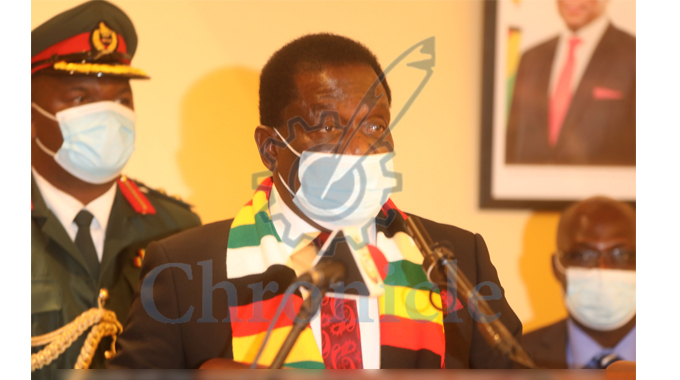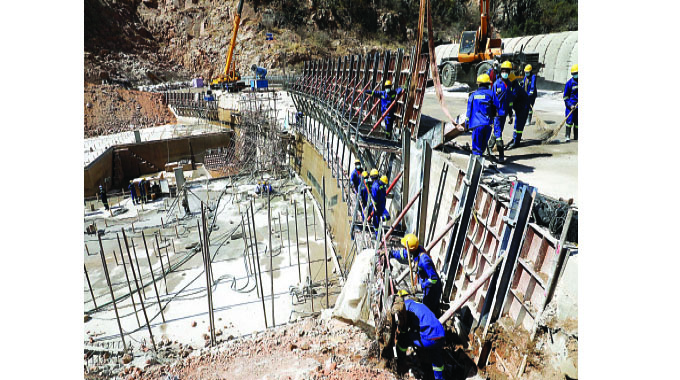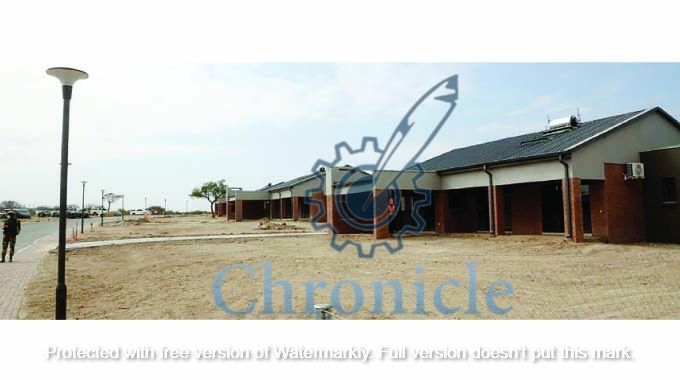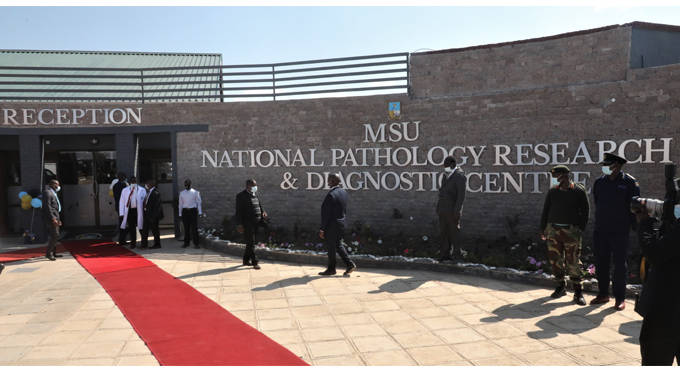The Chronicle

Prosper Ndlovu/Mashudu Netsianda, Chronicle Reporters
UPON assuming power in November 2017 President Mnangagwa immediately pronounced that “Zimbabwe is open for business” and declared his bold desire to transform the country’s economy and politics through fostering inclusive development that ensures ‘no one and no place’ is left behind.
These ideals had to be clearly articulated in Government’s devolution-focused development policy whose implementation is fully expressed in the National Development Strategy (NDS1:2021-2025), a key building bloc towards attainment of the desired upper middle-income economy by 2030.
Fast-forward to date, Zimbabwe is completely different from where it was four years ago. Despite the existence of sanctions and external macro-economic shocks such as the disruptive Covid-19 and the adverse impact of the Russia-Ukraine war, progress on the ground shows that under President Mnangagwa, the country is poised for a brighter future.
Beginning with the tough ‘but necessary’ austerity measures between 2018 and 2020, President Mnangagwa has pushed through comprehensive fiscal and monetary policy reforms that have successfully anchored Zimbabwe’s economy on a firm growth trajectory with revised growth projections of 4,5 percent this year from 7,8 percent last year.
Notwithstanding the short-term inflationary shocks, which have since been curtailed, analysts have said the ongoing developmental projects across the country are testimony to the able leadership under President Mnangagwa, who turns 80 today.
 President Emmerson Mnangagwa
President Emmerson MnangagwaUnder the New Dispensation, President Mnangagwa’s Government has been consistent in championing inclusive development, which has seen new capital investment projects as well as those that had stalled for years being rolled out in previously marginalised communities.
The southern region of the country, which covers Matabeleland provinces, Bulawayo and the Midlands, have not been left behind as they are actually host to a number of notable high-impact projects, which had failed to take off over the years and are now on course.
These include the Lake Gwayi-Shangani project, the US$1,4 billion Hwange Power Station Units 7 and 8 Expansion, Lupane Provincial Hospital construction and Elitsheni Government Complex also in Lupane town, Tuli-Manyange Dam project in Gwanda, the US$300 million modernisation and upgrading of Beitbridge Border Post as well as the massive roadworks under the Emergency Roads Rehabilitation Programme (ERRP).
 The Lake Gwayi-Shangani project
The Lake Gwayi-Shangani projectThe US$1,4 billion Hwange Thermal Power Station Unit 7 and 8 expansion project is one of the flagship projects being implemented to address power supply shortages in the economy as Zimbabwe transforms into an upper middle-income economy.
The project began in August 2018 following a ground-breaking ceremony by President Mnangagwa while the main construction of two additional coal-fired units of 300MW capacity each was started in March 2019.
Based on progress on the ground, the power utility, Zesa, has hinted that the first unit would be commissioned by November this year with the remainder slated for early 2023. When fully commissioned, the project will help Zimbabwe tame electricity imports and drive increased industrial production with guaranteed electricity, which is a key economic enabler.
The upgraded power station is expected to generate more than 60 percent of Zimbabwe’s electricity needs. The implementation of the project has seen more than 4 000 local people being employed directly.
The project is being implemented alongside the S$48,1 million Deka Pipeline Project, which will augment supply of water at Hwange Power Station. The Deka Upgrade project started on October 1, 2021 and is expected to be completed by March 31, 2023.
US$300 million Beitbridge modernisation project
Two weeks ago, President Mnangagwa commissioned completed works under the US$300 million Beitbridge Border Post modernisation and upgrade project, making a bold move towards implementing innovative financial instruments and solutions to modernise seamless and cost effective national and trans-boundary infrastructure.
The model, which will be replicated at other border posts, brings with it an array of benefits for the country and the entire Sadc region through the facilitation of trade, investment, business travel and tourism.

The project whose groundbreaking ceremony was presided over by President Mnangagwa in July 2018, is one of the key economic and developmental initiatives being spearheaded by the Second Republic. It has already transformed the face of the border town and created more than 1 400 jobs for locals in line with the National Development Strategy 1 (NDS1) and Vision 2030, which seeks to attain an upper middle-income economy.
Lake Gwayi Shangani success
Speaking at one of the celebration rallies at Nabushome Primary School in Hwange on March 16, 2018, President Mnangagwa pledged to do everything in his power to make sure the Lake Gwayi- Shangani project is completed on record time, among other key projects in the region.
The implementation of this major component of the National Matabeleland Zambezi Water Project, which was mooted way back in 1912, has been accelerated by the Second Republic.
The project is now nearing completion with the contractor working on nightshifts to ensure completion deadline is met. Work on the 249km pipeline from the Lake to Bulawayo has also started and plans are underway to establish a greenbelt along the pipeline by implementating an irrigation masterplan that will benefit communities.
 File picture: Lake Gwayi-Shangani under construction
File picture: Lake Gwayi-Shangani under constructionThese projects have created massive employment for locals and business for local material supplies.
Commenting on this and other projects, Matabeleland North Provincial Affairs and Devolution Minister, Cde Richard Moyo, said President Mnangagwa was a people-oriented leader who delights in achievements not words as he continues to spearhead high impact development projects in the region.
“Since the advent of the Second Republic in 2017, President Mnangagwa has been at the forefront in terms of driving economic growth and development in Matabeleland region,” he said.
“The high impact projects are a testimony of a leader who walks the talk when it comes to development.”
Industry revival and job creation
The revival of domestic industries is among top priorities for President Mnangagwa who has repeatedly rallied industry captains to embrace technology to improve efficiencies and substitute imports.
Through enhanced fiscal policy support and facilitation of formal access to forex, many companies are finding their feet as evidenced by the jump in capacity utilisation to about 60 percent from 56 in 2021 and 47 percent in 2020, according to official estimates.
As a result, Bulawayo industries are on recovery mode with several local firms, including small to medium indigenous enterprises now producing more with focus on exports. The latest offshoot is the recent re-opening of the Cold Storage Company (CSC) under an investment deal with United Kingdom registered company – Boustead Beef. Vice President Dr Constantino Chiwenga presided over the re-opening of the giant factory which has been closed for 20 years. Its revival is expected to impact positively on the wider leather and beef processing value chain.
 Vice-President Chiwenga (second from right) listens to CSC Boustead Beef Engineer Munyaradzi Masiswa (third from right) explaining the slaughtering procedure of cattle during the VP’s official opening of the CSC Boustead Beef processing plant at CSC recently. Listening on the right is the Minister of Lands, Agriculture, Water and Rural Resettlement Dr Anxious Masuka. Picture: Dennis Mudzamiri
Vice-President Chiwenga (second from right) listens to CSC Boustead Beef Engineer Munyaradzi Masiswa (third from right) explaining the slaughtering procedure of cattle during the VP’s official opening of the CSC Boustead Beef processing plant at CSC recently. Listening on the right is the Minister of Lands, Agriculture, Water and Rural Resettlement Dr Anxious Masuka. Picture: Dennis MudzamiriRiding on conducive business climate, the Second Republic has also attracted massive investments in the coal to energy value chain, which is domiciled in Hwange District of Matabeleland North. This has seen establishment of new coke processing companies such as Dinson Colliery and expansion by South Mining, Hwange Colliery and Makomo Resources, among others whose investments spread to power generation.
Road rehabilitation and upgrades
Under President Mnangagwa, the Government has stepped up the rehabilitation of critical roads in Matabeleland under the ERRP facility. Bulawayo is also a major beneficiary with 65 of its major roads, including Masiyephambili Drive, being targeted under an estimated $625 million budget. The Mberengwa-West Nicholson Road, which was recently rehabilitated, will become the shortest route linking Gweru to Beitbridge.
 The dualised carriageway from the border post to an intersection of the Beitbridge-Bulawayo Highway
The dualised carriageway from the border post to an intersection of the Beitbridge-Bulawayo HighwaySome of the roads earmarked for rehabilitation include the Beitbridge-Bulawayo Highway, Bulawayo-Maphisa Road, Bulawayo-Nkayi Road, Kwekwe-Nkayi-Lupane Road and the
Plumtree-Tsholotsho Road. In Beitbridge, the road network has been significantly transformed under the ongoing US$300 million modernisation of the border post.
Restoration of Old Bulawayo Historical Monument
The Second Republic is implementing the restoration of King Lobengula’s original capital, Old Bulawayo. The historical monument, which was built by King Lobengula in 1870 and was burnt down in 1881 to counter invasion by white colonialists, and is an important cultural heritage site for tourism and education. It is part of the Heritage Corridor launched by President Mnangagwa in June last year.
 President Mnangagwa, Vice-President Constantino Chiwenga and Minister of State for Bulawayo Provincial Affairs and Devolution Cde Judith Ncube are taken on a tour of the Hanging Tree by historian Pathisa Nyathi during a tour of the Heritage Corridor. (Picture Eliah Saushoma)
President Mnangagwa, Vice-President Constantino Chiwenga and Minister of State for Bulawayo Provincial Affairs and Devolution Cde Judith Ncube are taken on a tour of the Hanging Tree by historian Pathisa Nyathi during a tour of the Heritage Corridor. (Picture Eliah Saushoma)Bulawayo Provincial Affairs and Devolution Minister Judith Ncube lauded President Mnangagwa for his visionary leadership and commitment towards developing the region. She highlighted some of the developmental projects being undertaken by the Second Republic.
“First of all, I wish to congratulate the His Excellency, President Mnangagwa on his 80th birthday. As we celebrate his birthday, we are also mindful of his great works that he is doing in Bulawayo and the region as a whole,” she said.
“We are looking at the Lake Gwayi-Shangani, which will spur economic growth in the city through provision of clean water while weaning off some Bulawayo supply dams in Matabeleland South to cater for other developmental projects.”
Minister Ncube said in terms of the health sector, the Second Republic has transformed health institutions in Bulawayo.
“If you look at Thorngrove Hospital, it has been transformed into a world class facility and again Government refurbished burnt and dilapidated doctors’ residences at Mpilo Central Hospital and not forgetting the expansion of the specialist paediatric facility, CURE Children’s Hospital of Zimbabwe,” she said.
Minister Ncube also noted progress in roads rehabilitation under the ERRP initiative as well as progress in reviving industries in the city.
Focused transformation of Binga
President Mnangagwa has committed himself to lead the development of Binga, which for years has been regarded as a marginalised and backward district. True to his word, President has personally visited Binga and has now started implementing high-impact projects in the district in line with his thrust that no one and no place will be left behind in national development.
He has directed implementation of key projects such as rehabilitation of dilapidated roads, construction of a vocational training centre, a polytechnic and a new border post, setting up of a nursing school at Binga Hospital and the refurbishment and operationalisation of the hospital mortuary.
His Government is also finalising the construction of 27 houses for Binga floods victims while works are being done on the Siabuwa-Karoi Road which will cut by half the distance travelled from Harare to Binga.
 This room that is undergoing renovations is set to be used as a lecture room
This room that is undergoing renovations is set to be used as a lecture roomUnder President Mnangagwa, the Government recently completed the rehabilitation of the Binga Airstrip and is now working on remodelling the Bulawayo Kraal Irrigation Scheme, a massive irrigation project in the district.
A total of 250 hectares were cleared at Bulawayo Kraal Irrigation Scheme and already tilled at the scheme, which is set to be 15 000ha once the whole fenced area is cleared.
The construction of the civil registry department, which has stalled for 10 years recently resumed and is expected to be completed before year-end.
President Mnangagwa visited Binga in April and directed that several measures be taken to develop the previously marginalised district.
Enhancing food security through Intwasa/Pfumvudza model
In view of climate-change induced shocks, the Government has accelerated climate-proofing agriculture both at household and commercial levels as part of efforts to achieve food security and key industrial supplies.
Under President Mnangagwa, Zimbabwe has rolled out various agricultural schemes such as the Climate-Proofed Presidential Inputs Scheme, popularly known as Intwasa/Pfumvudza meant to transform subsistence agriculture at household level into commercial agriculture. About three million tons of maize are targeted during the 2022/23 summer cropping season and land preparation are already underway.
 President Mnangagwa and VP Chiwenga plant cotton during the national launch of the 2021/2022 Pfumvudza/Intwasa Programme in Nenyunga area in Gokwe North
President Mnangagwa and VP Chiwenga plant cotton during the national launch of the 2021/2022 Pfumvudza/Intwasa Programme in Nenyunga area in Gokwe North To achieve this, a total of eight Presidential Inputs Schemes have been set to capacitate farmers at different categories. These include the Presidential Inputs Scheme, the Presidential Cotton Scheme, the Presidential Blitz Tick Grease, Presidential Rural Horticulture Scheme, Presidential Community Fisheries Scheme, Presidential Rural Poultry Scheme, the Presidential Grain Protectant Scheme and the Presidential Rural Goat Pass-on Scheme.
More than 11 million people have been empowered through these measures amid significant progress in revitalising several irrigation schemes in the region to ensure food security.
The Tuli-Manyange Dam project
Government is focused on investing in key water projects around the country in line with President Mnangagwa’s rural industrialisation focus hence it has embarked on the construction of Tuli-Manyange Dam, which had stalled for years. In the 2022 national budget, the Treasury allocated $3,5 billion for site establishment, foundation excavations, grouting, backfilling to river bed level and construction of saddle dams and main dam embankment.
Once complete, the dam, which has a holding capacity of 35 million cubic metres is expected to provide raw water for irrigation purposes, which will boost food security for communities in Gwanda.
 Tuli-Manyange Dam construction project Engineer Paul Dengu (left) chats with the Minister of State for Presidential Affairs in charge of Implementation and Monitoring, Joram Gumbo (right) and Matabeleland South Minister of State for Provincial Affairs and Devolution Cde Abedicho Ncube (centre) during their tour of the project in Ntalale area in Gwanda District
Tuli-Manyange Dam construction project Engineer Paul Dengu (left) chats with the Minister of State for Presidential Affairs in charge of Implementation and Monitoring, Joram Gumbo (right) and Matabeleland South Minister of State for Provincial Affairs and Devolution Cde Abedicho Ncube (centre) during their tour of the project in Ntalale area in Gwanda DistrictUpon completion of the dam, about 2 000 hectares will be put under irrigation while another 3 000 hectares has also been proposed after the local community offered to donate their land.
Matabeleland South Provincial Affairs and Devolution Minister Abedinico Ncube, said the dam project, among other key developments in the province were critical to the overall performance of the economy.
He said there was a lot happening on the ground, which reflects on the Second Republic’s commitment to build the nation in line with the philosophy ‘nyika inovakwa nevene vayo/ilizwe lakhiwa ngabaninilo.”
Minister Ncube said the Tuli-Manyange Dam is a very important project in Matabeleland South, which is largely characterised by low rainfall.
“The recurrent droughts have eroded the sustenance capability and it’s therefore against this background that the Second Republic has given top priority to rain water harvesting. Tuli-Manyange Dam is a critical component,” he said.
Enhanced Healthcare Services
President Mnangagwa’s Government has committed to improving healthcare services through building and revamping health facilities as it works to achieve Vision 2030. This has seen several clinics and hospitals being built or upgraded since 2018 through devolution funds. The model has transformed the health sector with new clinics being built in several districts in Matabeleland as the Second Republic steps up the inclusive developmental philosophy of leaving no one and no place behind.
The programme has helped local authorities in Matabeleland and other parts of the country improve health service delivery, particularly in rural areas, where a majority of citizens used to walk long distances to seek services.
The philosophy behind devolution is to eliminate marginalisation by decentralising power to provincial and metropolitan councils. Quality health care services are among the pillars of an upper middle-class economy, which the Government is working to achieve by 2030.
 The completed Elitsheni Government Complex in Lupane in Matabeleland North
The completed Elitsheni Government Complex in Lupane in Matabeleland NorthIn that regard, the Government is constructing a 60-bed state-of-the art health facility in Bulawayo’s Cowdray Park suburb in line with the Second Republic’s commitment to accelerate the provision of adequate social infrastructure. Construction of the Lupane Provincial Hospital is also underway and last year the Government allocated $47 million for the project.
The project is progressing well with some sections of the facility likely to be commissioned soon. Upon its completion, the hospital will be the first provincial hospital for Matabeleland province.
At the same time the completion of Elitsheni Government Complex in Lupane is being speeded up and is expected to trigger the need for more services and more civil servants will be based in the town. Lupane State University has already relocated some of its departments, giving impetus to the growth of the provincial capital and the need for accommodation. To that end, the growth of Lupane has boosted the house construction sector with several entrepreneurs taking advantage of the opportunities.
Community Radio Stations and local language mainstreaming
The Second Republic has emerged a champion of promoting use of indigenous languages in mainstream development issues. This has seen the licensing and establishment of several community and campus radio stations in the region to buttress the devolution agenda.
These are Ntepe-Manama Community Radio Station in Gwanda, Radio Bukalanga in Bulilima, Inqanga Community Radio in Mbembezi, Bayethe FM in Maphisa, Liyejanyayi Community Radio in Hwange, Shashe Radio in Beitbridge and Twasumbuka Community radio in Binga. It appears Matabeleland region has the highest number of community radio stations.
 Ntepe community Permsec Nick Mangwana
Ntepe community Permsec Nick MangwanaThis is in addition to campus radio stations at the National University of Science and similarly, Government has also decentralised e-passport services to Beitbridge District, established the Lupane State University (LSU) agro-innovation and industrial park and constructed Gwanda State University’s engineering laboratory and innovation complex.
Massive housing development
The Second Republic is pushing construction of decent houses for civil servants and accommodation for students in line with the dictates of the Zimbabwe National Human Settlements Policy (ZNHSP), which was launched by President Mnangagwa last year in September.
Under ZNHSP, the country aims to build 225 000 housing units by 2025 with construction, which will have a ripple effect on other sectors of the economy such as the manufacturing industry, already underway.

The policy is in line with Vision 2030 and also dovetails with other regional and international development policies. It integrates implications of climate change with aspects of rural and urban settlement planning, development and management.
In Lupane, civil works for the 19 houses earmarked for civil servants have started at the Lupane Hlalani Kuhle housing project, which had stalled for years. Last year in November, President Mnangagwa commissioned 28 staff houses for civil servants in Beitbridge. The houses are part of the 52 houses, 16 garden flats and 250 core houses, which fall under the Beitbridge Redevelopment programme.
The trajectory towards attainment of Vision 2030 revolves around providing human settlements, which meet the aspirations of citizens while also addressing aspects of affordability and modernisation. The policy has attracted huge by-in from the diaspora community and private funders who have found a safe haven for investment in property development.
Progress in the Midlands province
Among the numerous development milestones being championed by the Second Republic in the Midlands province is the establishment of the US$1 billion iron and steel factory at Manhize near Mvuma and the state-of-the-art Midlands State University (MSU) National Pathology and Diagnostics Centre. This is in addition to the numerous ongoing major infrastructure upgrades, improved agricultural output and revival of key industries mainly in the mining and manufacturing sector, which are contributing more to job creation and enhanced domestic production.
US$1 billion Manhize Iron and Steel Plant
For many years Zimbabwe has struggled to attract major investments. However, the Manhize Iron and Steel Plant is set to make Mvuma a major industrial town while also making Zimbabwe one of the biggest global steel producers in the world, driven by competitive prices as the bulk of raw materials would be obtained within a 400km radius.
The construction of the US$1 billion iron and steel plant on a 250-hectare piece of land is being undertaken by Dinson Iron and Steel Company (DISCO), a subsidiary of global steel giant Tsingshan Holdings of China. The project sits at the confluence of Mashonaland East, Mashonaland West and Midlands provinces. Already, it has recruited a 600-strong workforce of skilled, semi-skilled and unskilled personnel and at its peak it will create up to 3 000 jobs, 90 percent of of the workers will be locals.
 The site of what will be Africa’s biggest iron ore mine and a carbon steel plant in Manhize, Mvuma in Midlands Province
The site of what will be Africa’s biggest iron ore mine and a carbon steel plant in Manhize, Mvuma in Midlands ProvinceThe investment comes on the back of the world grappling with a steel shortage after the Russia-Ukraine conflict saw the destruction of the Azovstal steel plant in Mariupol, which used to produce about four million tonnes of steel a year. Zimbabwe under President Mnangagwa is, thus, positioning itself to become a net producer and exporter of steel via the railway linking Zimbabwe and Mozambique while new railway routes are being drawn to augment rail traffic movement for coal and steel, all destined for Maputo enroute to global markets. This project alone, is expected to earn Zimbabwe the much-needed foreign currency, thanks to President Mnangagwa’s visionary leadership.
MSU National Pathology and Diagnostics Centre
One of the unforgettable political incidents before President Mnangagwa assumed power was his near-death experience in 2017 as a result of food poisoning at a rally in Gwanda, Matabeleland South. He had to be airlifted to South Africa for emergency treatment.
This encounter inspired the President to drive investments towards improving health delivery including domesticating pathological and diagnostics services. His vision and leadership have already seen establishment of the state-of-the-art Midlands State University (MSU) National Pathology Research and Diagnostic Centre in Gweru, which is the largest in the country.
President Mnangagwa officially commissioned the new facility on 15 July this year, buttressing the broad and cross-cutting technology and innovation initiatives, which are at the heart of the country’s Education 5.0 Philosophy under the Second Republic.

The new pathological facility, which is part of the university’s medical school, was built using Government resources and has been completed on record time after President Mnangagwa laid its foundation stone last year.
It is expected to scale up provision of quality health services for citizens and help Zimbabwe realise Universal Health Coverage targets.
Further, the modern centre is expected to address the shortage of local pathologists and help save
foreign currency spent on outsourcing services.
It will also increase access to pathology and diagnostic services to a cross-section of people in the Midlands province, across the country and regionally.
Article Source: The Chronicle
